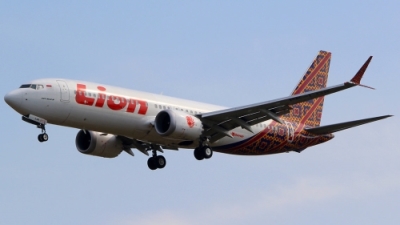Boeing 737 MAX 8 Aircraft Crash
Products liability law protects consumer’s rights when a manufacturer fails to properly design or manufacture a product, or fails to warn about dangers associated with the product. The legal system allows to individuals who seriously or fatally injured by a defective and hazardous product to recover compensation. The product may be as small and simple as a child’s toy, a component in a car (for example, airbags or defective brakes), the drugs or medications prescribed by a physician, or involve a large and complex product such as a commercial airliner.
A recent example of a potentially hazardous product arises out of the recent Lion Air crash of a Boeing 737 MAX 8 aircraft. This accident is raising serious concerns about the aircraft’s systems and training materials provided to airlines that operate this airplane. As the 737 MAX 8 began airline service in 2017, it is one of the newest airplane models flying throughout the world.

This is not a photo of Lion Air aircraft involved in the Oct. 29, 2018 accident, but is a photo of a similar aircraft.
Although the crash is still under investigation and no definite conclusions have been reached, focus has been drawn to the potential failure of a sensor that is sending false readings to the airplane’s onboard computers. An automatic flight control system then points the airplane’s tail downward, causing the aircraft to dive toward the ground.
Pointing the tail downward in this situation is not the result of actions taken by the pilot. Instead, the flight computer commands the airplane to point its nose toward the ground based upon the erroneous data. If this occurs, the pilots may not have sufficient time to recover from the dive. Consequently, the airplane could crash, fatally injuring its passengers and crew.
Because of the seriousness of the potentially faulty 737 MAX 8 instruments, the Federal Aviation Administration issued an Emergency Airworthiness Directive to all airlines that fly the 737 MAX 8. An Airworthiness Directive is an action by the FAA to correct an unsafe situation and safety defect. In addition, Boeing released a bulletin warning pilots of the potential problems associated with this system.
The problem goes deeper than simply faulty instruments sending erroneous data to the flight computers. Some airline pilot unions claim Boeing installed new automated systems on the 737 MAX 8 without informing the airlines. Because the airlines and their pilots lacked information about this new system, the claim they were not equipped to respond to a situation if the airplane entered an uncommanded dive. However, another pilot union claims its pilots already had the necessary training to handle this type of malfunction.
The FAA’s Emergency Airworthiness Directive and Boeing’s bulletin explaining the new emergency procedures might allow pilots to respond to a similar situation and recover from the dive. However, for the crew and passengers of the Lion Air flight, it is too little, too late.
The Boeing 737 MAX 8, its computer systems, and training materials are products that should not pose hazards to the flying public or its flight crews. Design failures and insufficient warnings subject manufacturers to recourse through our legal system.
